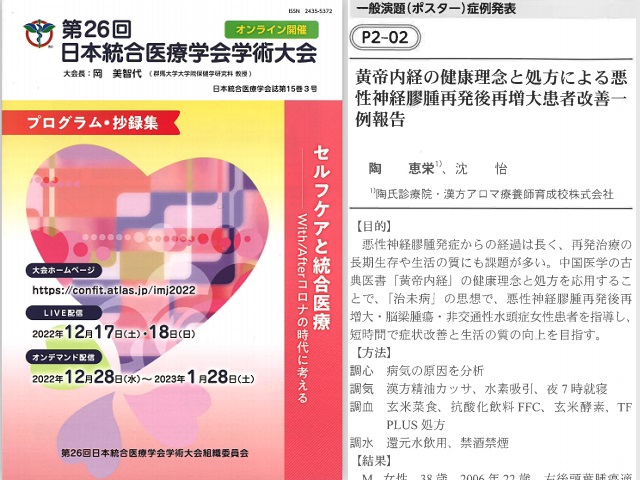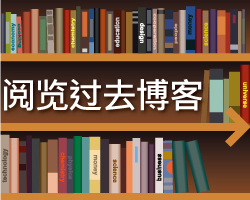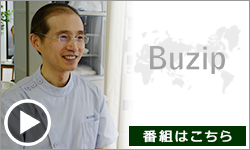2025-12-12
东瀛万事通・今日头条・中文導報・日本东方新报:北海道中国会举办第十二届总会&恳亲忘年会
2025-11-06
2025年北海道华侨华人春节联欢会盛大举行
2025-08-25
2025年“札幌中国节”成功举行 彩绘水墨画惊艳北海道 美声颂歌回响红砖广场
2025-07-31
陶永芳:我是世上最幸福的老人
2025-07-30
陶永芳:回想在日本住院的那些日子
2025-07-16
第2届全日本华侨华人业余高尔夫锦标赛&第11届北海道中国会杯高尔夫大会成功举行
2025-07-02
第60届中国人殉难者全道慰灵祭在北海道仁木町民中心举行
2024-12-16
肿瘤整合治疗联盟:第二届肿瘤整合治疗学术研讨会成功举办
2025-06-14
汗,是脾胃的镜子
2025-05-22
教你如何区分阴虚和阳虚,一学就会!
2025-02-24
艾灸最怕这一个字!90%的人做错,这样灸比吃补品更有效
2025-02-23
这些常见中药搭配,用对效果加倍
2025-02-02
中医和西医在治病原则区别
2025-02-01
李可老中医的一句话,拯救了无数肿瘤患者!
2025-01-26
仝小林院士:体病药论与治未病
2025-01-11
从五运六气看六经辨证
2023-12-06
黄帝内经治未病陶氏疗法在日本临床应用25年研讨⑪
2024-12-09
放几滴血,口腔溃疡就会痊愈,不信你试试!
2024-12-03
三魂七魄,看看哪个已不在您身上?
2024-12-02
中文导报 东瀛万事通 今日头条:北海道中国会举办第十一届总会&恳亲会
2024-11-09
艾烟,到底有没有害?
2024-10-13
经络不通,补什么都没用!只用一招:经络通畅百病消!
2024-10-08
你每天这样吸收大量阴气,怎么可能不生病?
2024-10-05
中医觉醒,认识经方——读懂《伤寒论》
2024-09-23
奥运体操全能王冈慎之助助阵:DENBA Moblie新品东京发表
2024-09-21
这样刮刮痧,活到八十八
2024-09-17
王振义被授予“共和国勋章”!他曾说:用循证研究证明中医药是个“宝”
2024-09-13
浙大调查发现:喜欢锻炼的人,患脑梗概率比久坐不动的人高数倍?
2024-09-04
“2024札幌中国节”成功举行 :彩绘水墨画惊艳北海道
2024-09-02
灸12原穴,断全身百病
5
黄帝内经治未病陶氏疗法在日本临床应用25年研讨⑪
2022.12.脑胶质瘤复发25)
女性、38岁。2006年11月(22岁),因脑胶质瘤接受手术切除。2007年1月,接受了5局部放疗、化疗(中途因过敏而停止),然后接受IFOS+CDDP, 4 个后进入缓解期。 2017年左脑室复发,2019年扩大并诊断为播散性复发,同年12月病理检查为间变性少突胶质细胞瘤(A0)。由于担心认知功能障碍恶化而拒绝了放疗。 2021年9月,MRI显示病灶增大,仍拒绝放疗和化疗。2022年6月底,认知功能障碍、步态障碍、尿失禁、记忆障碍迅速进展,肿瘤也出现明显增大。和脑积水。主治医确定错过了手术、放疗和化疗的时机,7月5日来陶氏诊疗院就诊。第一次治疗后,他的面部表情好转,笑容恢复,步态也好转。回家后,尿失禁得到改善。经过七次治疗后,7月20日,非交通性脑积水接受了脑室腹腔分流手术。尿失禁、步态障碍改善,出院后恢复陶氏疗法。替莫唑胺每晚口服220 mg。逐步减量,2023年6月结束。陶氏疗法仍在继续,患者康复了日常生活。
December 2022: Recurrence of Glioma25)
Female, 38 years old. She underwent surgical resection for glioma in November 2006, at 22 years old. In January 2007, she underwent 5 localized radiotherapy treatments and chemotherapy (stopped due to an allergy), then IFOS+CDDP, and entered remission four months later. In 2017, she had a left ventricular recurrence and was diagnosed with disseminated recurrence in 2019, pathologically examined as interstitial oligodendroglioblastoma (A0) in December that year. She declined radiotherapy due to concerns about worsening cognitive dysfunction. In September 2021, an MRI showed an enlarged lesion, but she still refused radiotherapy and chemotherapy. By the end of June 2022, cognitive dysfunction, gait disturbances, urinary incontinence, and memory issues had rapidly progressed, and the tumor had significantly enlarged, along with hydrocephalus. The attending physician determined that the time for surgery, radiation, and chemotherapy had passed, and she visited the Tao Clinic on July 5. After her first treatment, her facial expressions improved, her smile returned, and her gait improved. Upon returning home, her urinary incontinence improved. After seven treatments, on July 20, she underwent ventriculoperitoneal shunt surgery for non-communicating hydrocephalus. Her urinary incontinence and gait disturbances improved, and she resumed Tao therapy after discharge. She was administered 220 mg of temozolomide orally every night, gradually reduced, and ended in June 2023. Tao Method continues, and the patient has recovered her daily living activities.
2023.12.嗜酸性肉芽肿性多血管炎(又称 Churg-Strauss 综合征)26)
女性、47岁。2022年2月感染新冠,哮喘发病入院。辉瑞公司新冠病毒治疗药物PAXLOVID™五天治疗后哮喘改善。7月开始四肢发热疼痛,诊断为纤维肌痛,服用泼尼松龙60mg,出院时降至20mg。四肢疼痛和麻痹再燃,只能坐轮椅就诊。9月4日来陶氏诊疗院开始接受陶氏疗法治疗。初次治疗后,四肢疼痛缓解,恢复自行行走,第二天参加儿子运动会,一起奔跑。此后疼痛逐渐缓解,有时疼痛消失。10月上旬因感冒高热,入院三天检查,MPO-ANCA( 抗髓过氧化物酶-抗中性粒细胞胞浆抗体)290.0U/ml(正常3.5以下),嗜酸性粒细胞7700/ul(正常は40-400),诊断为嗜酸性肉芽肿性多血管炎。在坚持陶氏疗法的同时,并用激素加免疫抑制剂治疗。至12月,MPO-ANCA20.8U/ml、嗜酸性粒细胞38/ul,和其他血象恢复正常。2023年2月,停用免疫抑制剂,泼尼松龙在减量中,现在每天5mg。9月受孩子感冒影响,发热至38.5度,没有增加药物,体温恢复正常。现在能和孩子们一起玩耍,恢复正常生活。
December 2023: Eosinophilic Granulomatous Polyangiitis (Churg-Strauss Syndrome) 26)
Female, 47 years old. In February 2022, she was infected with the novel coronavirus and admitted to the hospital with the onset of asthma. Her asthma improved after five days of treatment with Pfizer's COVID-19 therapy drug PAXLOVID™. In July, she began experiencing feverish pain in her limbs and was diagnosed with fibromyalgia; she was given 60 mg of prednisolone, which was reduced to 20 mg at discharge. Her limb pain and paresthesia rekindled, confining her to a wheelchair for appointments. On September 4, she began Tao Method treatment at the Tao clinic. After the initial treatment, her limb pain was relieved, and she resumed walking independently; the next day, she participated in her son's sports day and ran together. Since then, the pain gradually subsided, sometimes disappearing completely. In early October, due to a cold with high fever, she was hospitalized for three days; tests showed MPO-ANCA at 290.0 U/ml (normal below 3.5) and eosinophils at 7,700/ul (normal 40-400), leading to a diagnosis of eosinophilic granulomatous polyangiitis. She continued Tao Method while being treated with steroids and immunosuppressants. By December, her MPO-ANCA was 20.8 U/ml, eosinophils 38/ul, and other blood tests had returned to normal. In February 2023, immunosuppressants were discontinued, and she was tapering off prednisolone, now at 5 mg per day. In September, affected by her child's cold, her fever rose to 38.5 degrees, but her temperature normalized without increasing medication. She can now play with her children and has returned to a normal life.
结语
黄帝内经治未病理念,是对全体社会成员的的健康指导。以黄帝内经治未病理念,可以创造健康社会,其前景无量。医疗预防和治疗,来源于民众,服务于民众,实惠于民众,造福于社会。希望来源于黄帝内经治未病理念的陶氏疗法,能为当今社会的医疗问题和老年人问题有所启发。
Conclusion
The Yellow Emperor’s Inner Canon concept of treating future diseases is a health guide for all members of society. With the concept of Yellow Emperor’s Inner Canon, a healthy society can be created and its prospects are unlimited. Medical prevention and treatment come from the people, serve the people, benefit the people, and benefit the society. It is hoped that Tao Method, which is derived from the concept of Yellow Emperor’s Inner Canon for the treatment of future illnesses, can shed some light on the medical problems and problems of the elderly in today's society.
女性、38岁。2006年11月(22岁),因脑胶质瘤接受手术切除。2007年1月,接受了5局部放疗、化疗(中途因过敏而停止),然后接受IFOS+CDDP, 4 个后进入缓解期。 2017年左脑室复发,2019年扩大并诊断为播散性复发,同年12月病理检查为间变性少突胶质细胞瘤(A0)。由于担心认知功能障碍恶化而拒绝了放疗。 2021年9月,MRI显示病灶增大,仍拒绝放疗和化疗。2022年6月底,认知功能障碍、步态障碍、尿失禁、记忆障碍迅速进展,肿瘤也出现明显增大。和脑积水。主治医确定错过了手术、放疗和化疗的时机,7月5日来陶氏诊疗院就诊。第一次治疗后,他的面部表情好转,笑容恢复,步态也好转。回家后,尿失禁得到改善。经过七次治疗后,7月20日,非交通性脑积水接受了脑室腹腔分流手术。尿失禁、步态障碍改善,出院后恢复陶氏疗法。替莫唑胺每晚口服220 mg。逐步减量,2023年6月结束。陶氏疗法仍在继续,患者康复了日常生活。
December 2022: Recurrence of Glioma25)
Female, 38 years old. She underwent surgical resection for glioma in November 2006, at 22 years old. In January 2007, she underwent 5 localized radiotherapy treatments and chemotherapy (stopped due to an allergy), then IFOS+CDDP, and entered remission four months later. In 2017, she had a left ventricular recurrence and was diagnosed with disseminated recurrence in 2019, pathologically examined as interstitial oligodendroglioblastoma (A0) in December that year. She declined radiotherapy due to concerns about worsening cognitive dysfunction. In September 2021, an MRI showed an enlarged lesion, but she still refused radiotherapy and chemotherapy. By the end of June 2022, cognitive dysfunction, gait disturbances, urinary incontinence, and memory issues had rapidly progressed, and the tumor had significantly enlarged, along with hydrocephalus. The attending physician determined that the time for surgery, radiation, and chemotherapy had passed, and she visited the Tao Clinic on July 5. After her first treatment, her facial expressions improved, her smile returned, and her gait improved. Upon returning home, her urinary incontinence improved. After seven treatments, on July 20, she underwent ventriculoperitoneal shunt surgery for non-communicating hydrocephalus. Her urinary incontinence and gait disturbances improved, and she resumed Tao therapy after discharge. She was administered 220 mg of temozolomide orally every night, gradually reduced, and ended in June 2023. Tao Method continues, and the patient has recovered her daily living activities.
2023.12.嗜酸性肉芽肿性多血管炎(又称 Churg-Strauss 综合征)26)
女性、47岁。2022年2月感染新冠,哮喘发病入院。辉瑞公司新冠病毒治疗药物PAXLOVID™五天治疗后哮喘改善。7月开始四肢发热疼痛,诊断为纤维肌痛,服用泼尼松龙60mg,出院时降至20mg。四肢疼痛和麻痹再燃,只能坐轮椅就诊。9月4日来陶氏诊疗院开始接受陶氏疗法治疗。初次治疗后,四肢疼痛缓解,恢复自行行走,第二天参加儿子运动会,一起奔跑。此后疼痛逐渐缓解,有时疼痛消失。10月上旬因感冒高热,入院三天检查,MPO-ANCA( 抗髓过氧化物酶-抗中性粒细胞胞浆抗体)290.0U/ml(正常3.5以下),嗜酸性粒细胞7700/ul(正常は40-400),诊断为嗜酸性肉芽肿性多血管炎。在坚持陶氏疗法的同时,并用激素加免疫抑制剂治疗。至12月,MPO-ANCA20.8U/ml、嗜酸性粒细胞38/ul,和其他血象恢复正常。2023年2月,停用免疫抑制剂,泼尼松龙在减量中,现在每天5mg。9月受孩子感冒影响,发热至38.5度,没有增加药物,体温恢复正常。现在能和孩子们一起玩耍,恢复正常生活。
December 2023: Eosinophilic Granulomatous Polyangiitis (Churg-Strauss Syndrome) 26)
Female, 47 years old. In February 2022, she was infected with the novel coronavirus and admitted to the hospital with the onset of asthma. Her asthma improved after five days of treatment with Pfizer's COVID-19 therapy drug PAXLOVID™. In July, she began experiencing feverish pain in her limbs and was diagnosed with fibromyalgia; she was given 60 mg of prednisolone, which was reduced to 20 mg at discharge. Her limb pain and paresthesia rekindled, confining her to a wheelchair for appointments. On September 4, she began Tao Method treatment at the Tao clinic. After the initial treatment, her limb pain was relieved, and she resumed walking independently; the next day, she participated in her son's sports day and ran together. Since then, the pain gradually subsided, sometimes disappearing completely. In early October, due to a cold with high fever, she was hospitalized for three days; tests showed MPO-ANCA at 290.0 U/ml (normal below 3.5) and eosinophils at 7,700/ul (normal 40-400), leading to a diagnosis of eosinophilic granulomatous polyangiitis. She continued Tao Method while being treated with steroids and immunosuppressants. By December, her MPO-ANCA was 20.8 U/ml, eosinophils 38/ul, and other blood tests had returned to normal. In February 2023, immunosuppressants were discontinued, and she was tapering off prednisolone, now at 5 mg per day. In September, affected by her child's cold, her fever rose to 38.5 degrees, but her temperature normalized without increasing medication. She can now play with her children and has returned to a normal life.
结语
黄帝内经治未病理念,是对全体社会成员的的健康指导。以黄帝内经治未病理念,可以创造健康社会,其前景无量。医疗预防和治疗,来源于民众,服务于民众,实惠于民众,造福于社会。希望来源于黄帝内经治未病理念的陶氏疗法,能为当今社会的医疗问题和老年人问题有所启发。
Conclusion
The Yellow Emperor’s Inner Canon concept of treating future diseases is a health guide for all members of society. With the concept of Yellow Emperor’s Inner Canon, a healthy society can be created and its prospects are unlimited. Medical prevention and treatment come from the people, serve the people, benefit the people, and benefit the society. It is hoped that Tao Method, which is derived from the concept of Yellow Emperor’s Inner Canon for the treatment of future illnesses, can shed some light on the medical problems and problems of the elderly in today's society.








